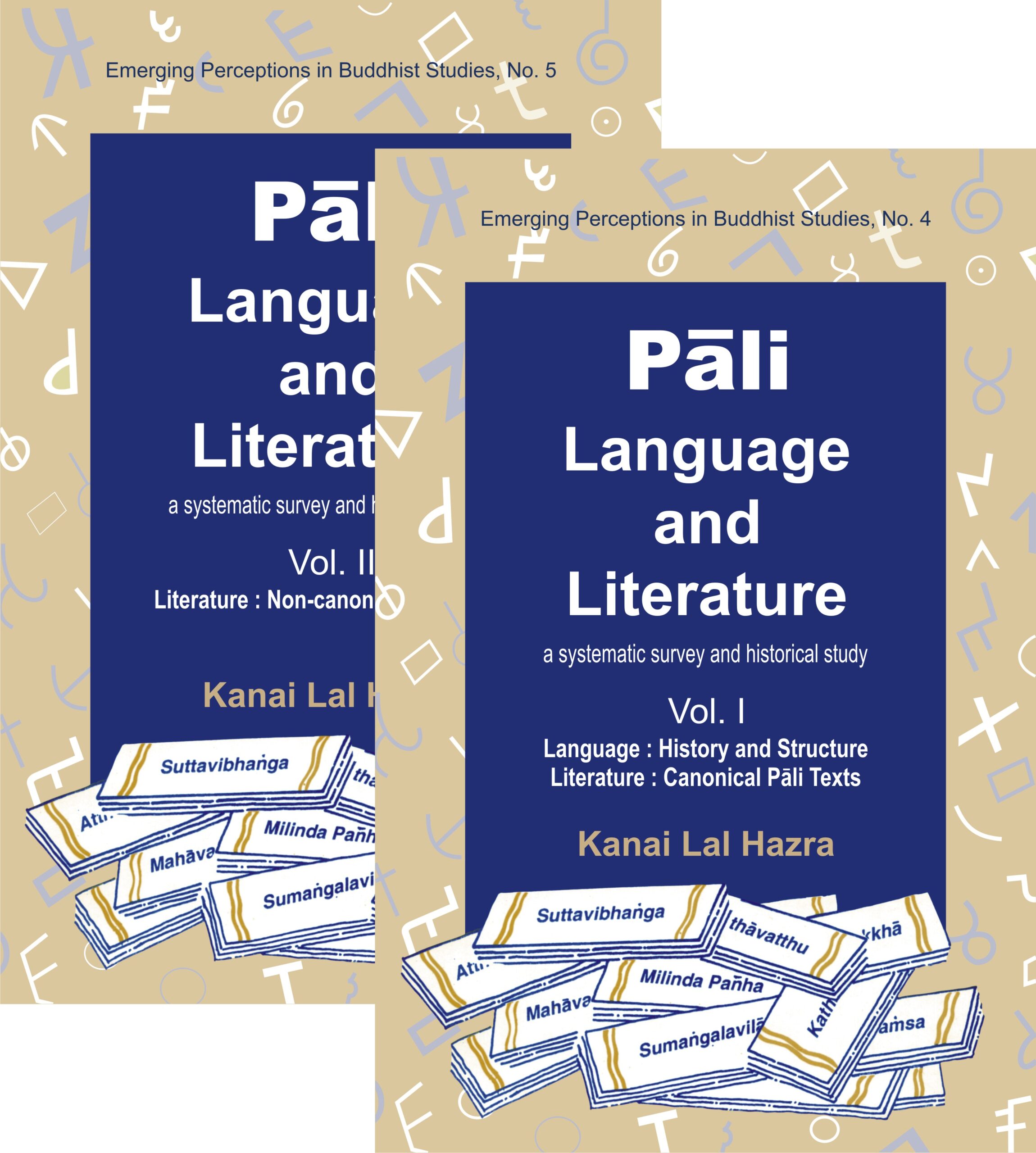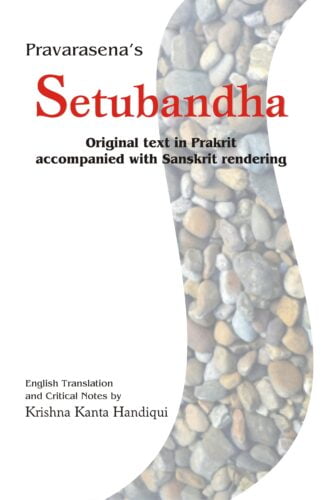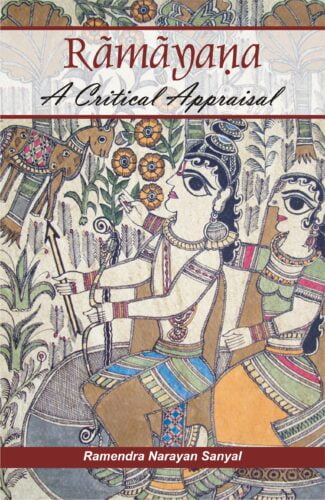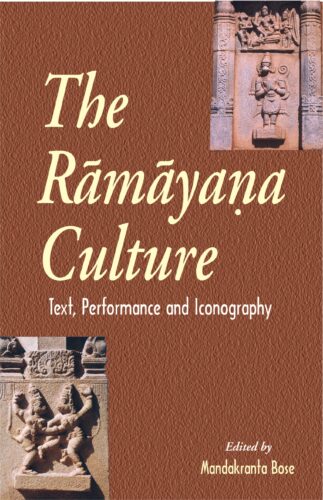Showing 131–140 of 220 results

Beginning with a description of the language, its historical evolution, phonology and grammatical categories, the book studies the canonical Pali texts (the three Pitakas) and surveys the non-canonical Pali literature covering manuals and chronicles.
In Pali is preserved the Buddhist canon. Which, considered as the most authentic form of Buddhavacana, constitutes the very matrix of its 2500-year-long Theravada tradition. A refined, widely-spoken language of the early Middle Indic (Indo-Aryan) stage: about bc 600-200, Pali has also left, for posterity, a splendid legacy of secular literature that captures contemporary socio-cultural milieus not only of India, but of Myanmar, Thailand, Sri Lanka, and other neighbouring countries as well. Here is, in two volumes, a fascinating, well-knit study of the Pali language, and also of its literature: both canonical and non-canonical. Beginning with a systematic description of the language, its historical evolution, phonology and major grammatical categories, VOLUME 1 takes an indepth, critical look at the canonical Pali texts all the three Pitakas : the three baskets (collections): the Vinaya, Sutta and Abhidhamma, which, among other things, embody Sakyamunis own universal message, the writings of his immediate monastic followers/disciples, the basic principles of shula (ethical behaviour), the disciplinary codes for the sangha and, above all, the Theravada philosophy in its truly pristine frame. VOLUME 2 surveys nearly the whole variety of Non-canonical Pali Literature covering creative writings, manuals, and as many as 25 chronicles: from Sri Lanka, Myanmar, and Thailand besides numerous commentaries of the old-world scholars, like Buddhadatta, Buddhaghosa, and Dhammapala. In focus here are also a range of treatises on law, grammar, lexicography, and poetics including rhetorics and metrics. A painstakingly documented work with a comprehensive index, involving years of Dr. Hazras research effort, this book is invaluable to the scholars/researchers of Buddhist Studies, specially of Theravada Buddhism, Pali language and Pali literature.

This book is a tale centred on the theme of the philosophic ideals and teachings of Vedanta. The story is an interesting account that is not only philosophical but also touches the emotions of the heart. It conveys the deeply founded truths of Vedanta in a simple manner.
This book is a tale centred on the theme of the philosophic ideals and teachings of Vedanta. With a first-person narrative style, it begins with the narrator’s decision to spend the third of the four asramas, the vanaprastha stage of life, in Madurai, the abode of Goddess Meenakshi which has inspired devout scholars and poets for centuries. The tale is an account of the narrator’s study of the philosophy of non-dualism or Advaita, as propounded by masters such as Sri Sankara and Ramana Maharshi, under the guidance of his guru Sankara Shastri. It reveals the nature of the Vedanta philosophy and its significance in understanding the meaning of life and the strange nature of human condition, in attaining peace and bliss in one’s own being and in contributing to harmony and integration in the country. It discusses aspects of creation of the universe and of life, the world and nature around us and the sufferings and pleasures as experienced by humans from a Vedantic perspective.
The story is an interesting account that is not only profoundly philosophical but also touches the emotions of the heart. Readers will be fascinated by this interesting and profound story that conveys the deeply founded truths of Vedanta in a simple manner.

Krishna Steals the Parijata (Parijataharana) tells the story of Krishna forcibly taking away Parijata from Indra to make Satyabhama happy, which finds expression in the paintings of different kalams Chamba, Palam, Early Kangra, Mature Kangra, Bundi, Bikaner and Nepal from different sources.
Krishna Steals the Parijata (Parijataharana) is a collection of a few accounts, edited by Harsha V. Dehejia, on Krishna forcibly taking away Parijata from Indra, which finds expression through the paintings of different kalams. Christopher R. Austin relates this event to the citations and narrations in Mahabharata and Harivamsha, wherein the focus is on Krishnas effort to appease his perturbed wife Satyabhama, by fulfilling her desire to have Parijata from Indras abode. Mahendra Kumar Mishra approaches this incident from Sarala Mahabharata angle. Here the narrative and episode are little different though the centre theme and characters remain the same.
The third narrative is in Hindi by Narmada Prasad Upadyaya. He approaches this story from a different viewpoint that by forcibly taking away the Parijata tree from Indraloka, Krishna broke Indras Himalayan pride. The main characters in the episode are same here too: Krishna, Indra and Satyabhama. In the final article, Harsha V. Dehejia provides a visual narrative account of the event. The story looks almost similar to that of Austin with little more narration and a few additional characters. The sequentially given paintings tell the story faster than the literature.
In a nutshell the book is an exemplar attempt to visually covey a well-known, well-rooted story where Krishna is the central character.
भारतवर्षीय दर्शन परम्परा में अनेक सम्प्रदाय, पद्धतियां, चिन्तन–मार्ग और साधना के आयाम हैं। वे सभी पद्धतियाँ मुख्यत: तीन ग्रन्थाें पर आधारित हैं। जिनमें कुमारिल भट्ट का श्लाेकवार्त्तिक, धर्मकीर्ति का प्रमाणवार्त्तिक, तथा गङ्गेश उपाध्याय का तत्त्वचिन्तामणि हैं। वे तीन ग्रन्थ आज तक की भारतीय दर्शन परम्परा के प्रतिनिधि ग्रन्थ हैं और तीन मार्गाें के रूप में स्थापित हैं। हम कुछ भी चिन्तन, लेखन या विचार करते हैं ताे वे इन तीनाें में से किसी एक मार्ग में स्वतः ही चले आते हैं।
धर्मकीर्ति का यह प्रमाणवार्त्तिक ग्रन्थ अत्यन्त कठिन हाेने से इस ग्रन्थ का अब तक किसी भी भाषा में पूर्ण रूप से अनुवाद नहीं हाे पाया है। इसके कुछ श्लाेक अंग्रेज़ी में अनुदित हैं ताे कुछ हिन्दीए फ्रेंचए जर्मन और नेपाली में भी अनुदित हुए हैं। किन्तु अब तक पूर्ण ग्रन्थ का और इसकी किसी भी टीका का पूर्ण अनुवाद न हाेना इसकी भाषा का कठिन हाेना, विचाराें का गूढ़ हाेना तथा अत्यन्त दुरुह प्रकरणाें का हाेना ही कारण रहा है। कुछ विदेशी विद्वान् इसका अंग्रेज़ी में अनुवाद करने के लिए भी लगे हुए हैं किन्तु बीसाें वर्षाें के बाद भी वे इसे पूरा नहीं कर सके हैं। अतः यह हिन्दी अनुवाद अपने आप में प्रथम पूर्ण अनुवाद और सम्पादन है।
प्रस्तुत ग्रन्थ में पाँच प्रकरण हैं – 1. प्रमाण सिद्धि परिच्छेद, मनाेरथनन्दी के साथय; 2. प्रत्यक्ष परिच्छेद, मनाेरथनन्दी के साथ; 3. स्वार्थानुमान परिच्छेद, स्वाेपज्ञवृत्ति सहित (जाे कि धर्मकीर्ति की अपनी ही वृत्ति है); 4. स्वार्थानुमान परिच्छेद, मनाेरथनन्दी के साथ; और 5. परार्थानुमान परिच्छेद, मनाेरथनन्दी के साथ।
इस ग्रन्थ में प्रथम बार समग्र प्रमाणवार्त्तिक का उपस्थापन किया गया है। इस में स्वयं धर्मकीर्ति की स्वाेपज्ञवृत्ति स्वार्थानुमान परिच्छेद में वर्णित है जिसका अनुवाद सहित उपस्थापन पाँचवें परिच्छेद के रूप में रखा गया है।

Prof. K.K. Handiqui’s English translation of Setubandha, with detailed introduction and notes, is a monumental work in Prakrit Mahakavyas. It is an onerous task with amazing accuracy and analytical acumen. This critical translation recovers and clarifies the original meanings, Pravarasena’s intentions and implications of poetic expression in Setubandha.
Literary traditions of Sanskrit and Prakrit were highly synchronized for the last two millennia, giving a fillip to arts, cultures and literary creativity. Pravarasena’s Setubandha (or Ravanavaho), a fifth-century composition and the first Mahakavya in Prakrit, is an excellent example of this synchronization, and it has exercised unmistakable influence on Bharavi and Magha.
This volume, Prof. K.K. Handiqui’s English translation of Setubandha with detailed introduction and notes, is a monumental work of the past century in Prakrit Mahakavyas. The author has undertaken this onerous task with amazing accuracy and analytical acumen. In this critical translation, Prof. Handiqui recovers and clarifies the original meanings, Pravarasena’s intentions and implications of poetic expression in Setubandha. While doing so, he has consulted vast mass of Sanskrit commentaries, without compromising his own authority. Therefore it brings to one’s attention Pravarasena’s meticulous style and his use of Prakrit language. This is the first comprehensive edition of Setubandha that includes the original text in Prakrit with its chaya in Sanskrit, a complete translation in English with exhaustive notes.
This scholarly title should invoke keen interest among the academia of Sanskrit and Prakrit, students and researchers, as it represents a significant phase in the development of Kavya poetry, after Kalidasa.
Precognitive dreams appear to predict the future through a sixth sense. Historically, there are a lot of references to precognitive dreams responsible for great discoveries and showcasing big happenings. This volume is an attempt to illuminate and rediscover precognition in dreams in a different perspective of investigation in the light of Kashmir Saivism about reality and consciousness.
In the process, the book introduces readers to dreams and consciousness, underlining evidences, references and descriptions of the phenomenon. To enlighten one on the concept of precognition on the basis of reflectionism, it illustrates the Pure and Reflected Consciousness, and how one attains spiritual powers like precognition through japa, dana, tapa, puja and so on, based on the findings from Tantraloka and Pratyabhijnasastra. Further, it surveys the complete philosophical physiology of precognitive dreams with respect to concepts like pramata, prameya and pramana.
While establishing a uniform principle lying in the back of precognition, it lets future scope for investigation on precognition and the myssteries of this phenomenon, giving the book a high referral value to all in the field of psychology and parapsychology.
The book investigates some of the most discoursed conducts centring around the characters in the Mahabharata, concluding that these characters reinstate ‘purusartha’ (four basic aspects of human existence) and its relevance in shaping constructive social–political standards and assuring intellectual, emotional and spiritual evolution for individuals from all walks of life. Through rationalized arguments, the book debunks age-old attitudes/perceptions that have kept these characters from being understood from beyond. This way, the book shifts its focus from studying the epic solely for its sacredness to seeking its relevance in the modern way of life and ways in which it can offer guidance through present-day challenges and struggles.
The book narrates the interwovenness of culture between India, Nepal, Tibet, Mongolia, China and Japan. It begins with Nepal with its history alive on the waysides and homes, its rich preservation of Buddhist sutras in Sanskrit, esp. the Tattvasangraha which lives in the Shingon denomination in Japan, in the icons of Alchi and in the grandeur of the Borobudur. The second chapter deals with Tibetan studies, edition of the Vinayavastu, the anachronism of Jesus Christ being in the Hemis monastery which was founded as late as the 17th century, the total destruction of Tibetan culture in a long letter of Prof. A.W. Macdonald, saving the Derge monastery and printery by seven encirclements of devotees under the supervision of Ven. Pewar Tulku at the risk of his life, and the Sven Hedin collection in Stockholm. The fourth chapter concerns Mongolian studies: Emperor Ch’ien-lung’s edition of the Mongolian Kanjur, and dialogues with Prof. Rinchen on the total cultural genocide in Mongolia

Written in a simple and lucid language, this book discusses the major events of the Ramayana, analysing and interpreting them from different angles. This volume should fascinate readers who want to gain a fresh perspective on the glorious Ramayana tradition.
Based on the Valmiki Ramayana, this book discusses the major events of the Ramayana including those in the Uttara-Kanda, analyzing and interpreting them with a fresh approach. Written in a simple and lucid style, the work deals with the birth of Rama, his destruction of rakshasas accompanied by his brother Lakshmana, of Dasaratha, Ramas exile, the many developments that led to the war between Rama and Ravana and the later events like Ramas coronation, his abandonment of Sita and the last journey of Lord Rama. It brings out the many qualities of Rama like virtuousness, courage, compassion, equanimity of mind, devotion to duty and truth, and selflessness that make Rama a glorious, divine figure and the story in the Ramayana an unparalleled epic of the world. It also discusses the controversial acts of Rama like his killing of Vali and humiliation of Sita after her rescue. It underlines the importance of the example of Rama and the teachings of the Ramayana in the contemporary world.
The volume will fascinate a range of readers general readers as well as scholars of Indian religion and culture who want to gain a fresh perspective on the glorious Ramayana tradition.

The essays in this volume approach the Ramayana from different perspectives textual criticism, art and architecture, and film to understand its ideological and aesthetic meanings. They address critical issues like the seminal status of Valmiki, gender representation in Ramayana and the importance of the so-called Ramayana derivatives.
These essays, originally presented at an international conference, are in the forefront of the modern response to an ancient work that has gained a new critical and social relevance in contemporary scholarship. Approaching the Ramayana from several angles in an attempt to understand its aesthetic and ideological meaning, they examine the epic through the perspectives of textual criticism, art, architecture and film. Thereby they address critical issues such as the seminal status of Valmiki, the underlying problem of canonicity itself, the importance of other — so-called derivative — Ramayanas, the implications of gender representation, and the cultural manipulation of social ideals relating to the position of women and the idealisation of love that achieves its highest value in marriage. Using the methods of rigorous textual and historical investigation, each essay seeks not only to uncover the layers of meaning in the complex structure of the epic in its varied forms but also to situate it critically in the cultures of South and Southeast Asia.
| There are no products |